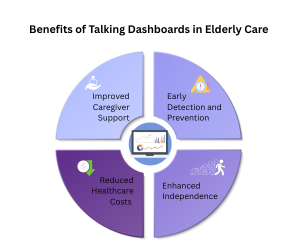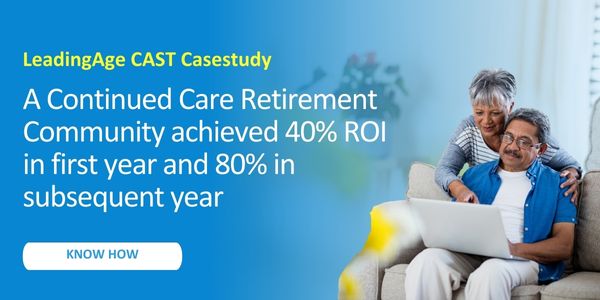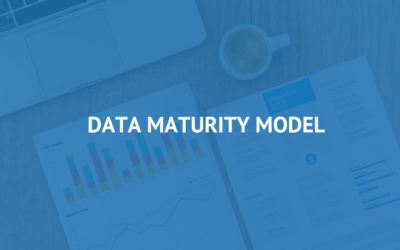AI-Powered Talking Dashboards: Transforming Fall Prevention in Elderly Healthcare
Every year, one in four seniors experiences a fall.
Every 11 seconds, a senior is treated in an emergency room due to a fall.
And every 19 minutes, a senior dies from one.
These statistics are sobering but what if we could predict falls before they happen?
Imagine simply asking a voice assistant, “Am I at risk of falling today?” Or “How’s my heart doing?” and getting a meaningful, data-driven response. Not just for falls, but for diabetes, hypertension, or cardiac conditions before symptoms even appear.
Welcome to the future of healthcare, where talking dashboards transform passive data into active fall prevention in elderly.
What Are Talking Dashboards?
Talking dashboards are AI-powered, voice-enabled platforms that interpret real-time health data from sources like wearables, smart home devices, and electronic medical records. Unlike traditional dashboards that require manual analysis or visual review, these systems communicate critical insights through voice, making them especially valuable for the elderly and their caregivers.
These platforms don’t just respond to questions, they continuously monitor and analyze health patterns to anticipate problems. Whether it’s detecting a slow change in mobility or a sudden spike in heart rate, they deliver timely alerts and interventions through natural conversation.
How Do They Work?
It all starts with data!
Wearables like smartwatches track heart rate, sleep, movement, and even gait. Smart home systems detect motion, temperature, and environmental hazards. Electronic Health Records (EHRs) provide historical data on chronic conditions, medications, and vital signs.
This massive pool of data is fed into Machine Learning models, that are trained to recognize patterns and anomalies. For example, if a senior begins to shuffle their feet more frequently, exhibits poor balance, or shows increased dizziness- the system interprets these signals as precursors to a fall. Instead of reacting after the fact, the dashboard issues a proactive warning.
Even better? These systems can connect with home automation tools. If motion is detected late at night, they can automatically switch on lights to prevent tripping.
Related
Blog: NuAIg’s Data Maturity Model for Senior Care Providers
Benefits of Talking Dashboards in Elderly Care
Early Detection and Prevention
Falls can lead to broken hips, head trauma, or worse. Talking dashboards discover the potential risks early, giving caregivers a chance to intervene by adjusting medications, adding support devices, or making home modifications.
Enhanced Independence
Many seniors fear losing autonomy! These dashboards empower them to live safely in their own homes, minimizing the need for 24/7 monitoring.
Reduced Healthcare Costs
Preventing just one fall can save thousands of dollars in the hospital and rehab bills. On a larger scale, these systems reduce strain on healthcare infrastructure by lowering emergency admissions.
Improved Caregiver Support
Family members and professional caregivers can receive real-time updates, alerts, and summaries, enabling smarter decisions and reducing the burden of constant in-person supervision.

Data Analytics Beyond Fall Prevention
These Gen AI-powered dashboards and data visualization aren’t just helpful in senior care homes! They are also transforming clinical settings too. Here are some key use cases:
Emergency Rooms
Physicians can ask, “What are the vitals for patient in Bay 3?” without touching a screen. Voice-activated access to data saves time, reduces errors, and keeps hands free for patient care.
ICUs and Remote Monitoring
In critical care environments, speed matters. Nurses can check on high-risk patients or access 24-hour vitals using voice commands, enabling faster and safer care.
Hospital Administration
Hospital managers can monitor bed availability, staffing needs, or infection trends using voice-activated dashboards, allowing for faster, data-backed operational decisions.
Chronic Disease Monitoring
For patients with heart disease, hypertension, or diabetes, dashboards track trends over time. A sudden blood pressure spike, for instance, could trigger alerts to both the physician and the patient’s family, potentially preventing a serious event.
Real-World Platforms
Amazon HealthLake + Alexa for Business
What it does: Merges structured and unstructured health data, enabling physicians to interact via Alexa.
Use case: “Alexa, summarize John Doe’s last lab results.”
Strength: Seamless AWS integration, ideal for hospitals already on the Amazon cloud stack.
Nuance DAX (Dragon Ambient eXperience)
What it does: Captures and transcribes patient visits in real time, integrating seamlessly with EHRs.
Use case: Physicians can focus on patients instead of documentation.
Strength: Medical-grade voice recognition with Microsoft’s AI backing.
Google Cloud Healthcare API + Dialogflow
What it does: Enables creation of conversational agents that interact with clinical data stored in Google Cloud.
Use case: “What’s the blood pressure trend in Room 402?”
Strength: Natural integration with Google’s AI and machine learning ecosystem.
Sensely
What it does: A virtual nurse avatar that communicates through voice and chat, connected to patient records and triage systems.
Use case: Ideal for remote monitoring, chronic condition check-ins, and patient education.
Strength: Combines empathy with AI for better patient engagement.
Why This Matters Now!
As healthcare systems worldwide face increased pressure, aging populations, rising costs, and workforce shortages, solutions like talking dashboards are no longer futuristic. They’re essential!
We’re entering a world where data isn’t just displayed, it speaks, warns, and prevents. These systems democratize access to insights, reduce human error, and shift healthcare from reactive to proactive.
And for seniors? It means fewer ER visits. Fewer broken bones. More independence. More dignity.
Final Thoughts
Talking dashboards are at the intersection of AI, natural language processing, wearables, and cloud computing. They don’t just make healthcare smarter; they make it more human.
The future of care is not only visual; it’s conversational.
And sometimes, a simple voice command might just save a life.
If you want to know more about talking dashboards or how we are utilizing Gen AI to create one, write to us at [email protected]





